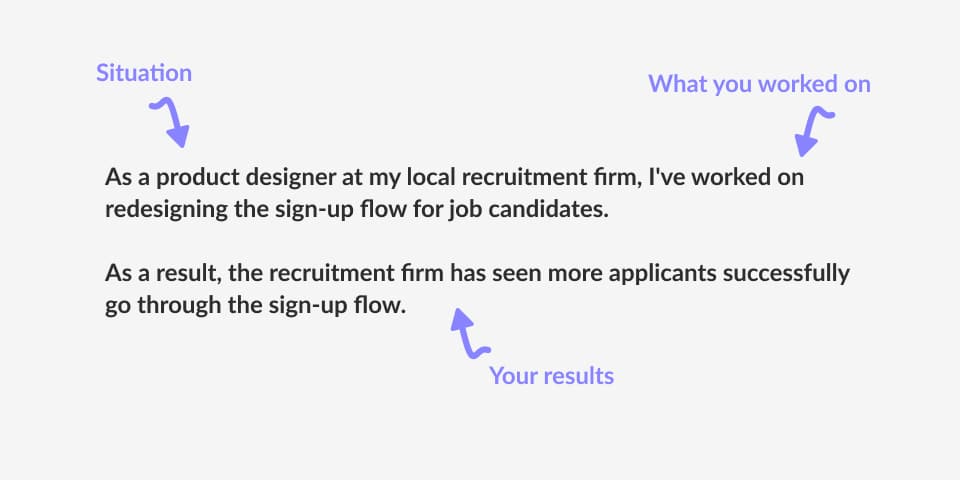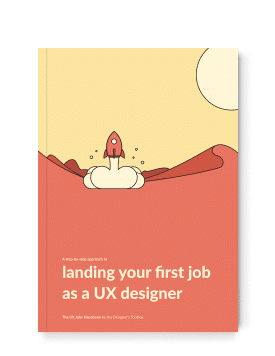Table of Contents 💡
Home - UX Portfolio - Tips on presenting your UX case study
Tips on presenting your UX case study
Imagine this. You’ve made it through the first job interview. You’re now asked for a second round interview to show your work. But how? And what do you need to keep in mind? Here’s how to present a UX case study during a job interview.
- Updated on May 9, 2024

This article will teach you how to present your UX case study during a job interview. If you follow along, you’ll increase your chances of getting invited to the next round. We’ll talk about the basics, such as attending the meeting on time, and more advanced tactics, like how you structure your presentation.
I’ve based the following tips on presenting my UX portfolio to multiple potential clients for years and the UX mentorships I’ve hosted for aspiring designers. In other words, these tips are based on real-world experience.
Table of Contents
How to present a UX case study
The most important aspect of giving an excellent UX case study presentation is showing that you can solve a business challenge.
Even though your main goal is to be there for the user, you can’t forget that you’re hired by a business to help that business make money. If you only talk about users and forget to mention how you can help your potential employer grow a business, you’re likely to miss out.
Then there are also some basic job interview rules to consider. Let’s discuss those basics first.
Presentation basics
These basics are essential. People expect you to follow them. Because of that, doing so will not get you any bonus points. However, failing to follow the basics will leave a bad taste during your interview. Make sure you can check the following basics off of your list.
- Arrive on time.
- Stable internet connection (remote only).
- Position yourself in the middle of your frame (remote only).
- Make sure you’re able to focus without disturbance (remote only).
- Make sure your camera and mic are working correctly (remote only).
Presentation basics
These basics are essential. People expect you to follow them. Because of that, doing so will not get you any bonus points. However, failing to follow the basics will leave a bad taste during your interview. Make sure you can check the following basics off of your list.
- Arrive on time.
- Stable internet connection (remote only).
- Position yourself in the middle of your frame (remote only).
- Make sure you’re able to focus without disturbance (remote only).
- Make sure your camera and mic are working correctly (remote only).
At some point during the interview, the interviewer will ask you to present your work. This means you can choose which of your case studies to pick. And that’s a good thing.
In my experience, there’s always a case study you prefer over your other case studies. Creating that particular UX case study has been easier, or the project has been more fun than your other projects.
So make sure you’re ready to pick one of your case studies on the spot if asked to. Pick the one you’re most comfortable with.
Start with a case study summary
Once you’re asked to present your UX portfolio, it makes sense to start explaining everything you’ve done. Try and stay away from doing that.
You’ll lose the attention of your crowd and put yourself in a position to receive challenging questions you can’t answer. Instead, give a summary first. Here’s what to include.
- The business challenge, what you were asked to do, and your role.
- What your main deliverable was.
- The results of your project and deliverable.
Here’s an example of what your UX case study summary might look like.

As a product designer at my local recruitment firm, I’ve worked on redesigning the sign-up flow for job candidates. As a result, the recruitment firm has seen more applicants successfully go through the sign-up flow.
This is a very short summary. And by doing so, you give those listening to your presentation the opportunity to ask questions. Because you keep a lot of information to yourself, chances are you get questions about that information. You can answer these questions with ease.
If you had presented every detail of your case study, you’re more likely to get questions you can’t answer.
Answering case study questions
After presenting your UX case study summary, it is time to answer questions. As I said, you leave room for questions on purpose to have more control over the type of questions you get.
My main advice here is to be honest when you don’t have an answer to one of the questions. I’ve seen many designers desperately try to answer every question they get. However, the people listening to your presentation will notice this.
Instead, be honest when you’re not sure. Let your audience know you’re willing to learn or return the question by asking what they think or what the company expects you to do.
That way, you show you know what you can improve and that you’re willing to have a good talk about it. That’s way more valuable than being someone that pretends to know everything.
Frequently asked questions
With the above structure, presenting your UX case study during a job interview should go much better. However, there are still some questions to be answered. I’ve collected several in the list below.
How long should a UX case study presentation be?
The length of your case study presentation depends on the structure of the interview. In almost all cases, that’s up to the hiring company. It is common for an interview to take between 30 and 60 minutes.
However, your UX case study presentation can be shorter than that. Those 30 or 60 minutes include the introduction, asking questions, and discussing the next steps as well. That leaves between 5 to 15 minutes for the actual case study presentation.
How many slides are in a UX case study presentation?
The number of slides in your UX case study can vary between 5 and 15. Less than that would mean that you don’t include the basics like the cover page, challenge, things you’ve done during the project, and your results.
However, when you go over 15 slides, you risk losing your audience’s attention. Be strict in the number of slides you include!
What should a UX presentation include?
Your presentation should include at least the main building blocks of your project. These include the business problem you’re solving, what the client has asked you to do, what you actually did, and the impact of your work.
Try making it very visual with mockups, photos of you working on the project, and a user testimonial from your tests. Before and after images also help you tell a better story.
Resources
UX Case Study (Course + Template)
I’ll walk you through the steps of creating a case study based on my 10 years of experience in UX.
- Video course and template.
- Includes real-world examples.
- Get personal feedback.
Summary
Case studies are what make up most of your UX portfolio. Therefore, being able to present them is a crucial skill you need to have when you want to get hired in UX.
These crucial steps will increase your chances of making it to the next round.
- Get the basics right. Make sure you’re on time, in a place where you can focus, and with a stable internet connection.
- Start with a summary of your case study to leave room for questions you can answer.
- Accept the fact that you can’t answer everything. It is better to acknowledge that than to try and desperately answer every question you get.
Do you have feedback on this article? Missing something? Or just a question? Reach out to me and I’ll get back to you!

About the author
Hi! I'm Nick Groeneveld, a senior designer from the Netherlands with experience in UX, visual design, and research. I'm a UX coach that supports other designers and have completed design projects in finance, tech, and the public sector.
Through The Designer's Toolbox, I'm an Educational Partner for Interaction Design Foundation.
☎️ Book a 1:1 mentor meeting with me or let's connect on LinkedIn, Twitter and Medium.



